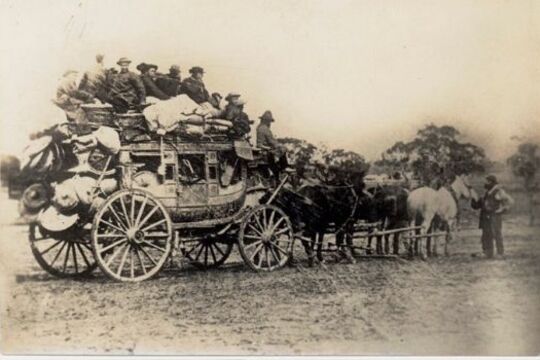Showing 2 items
matching Chinese Museum, themes: 'built environment','gold rush','local stories'
-

Language, A Key to Survival: Cantonese-English Phrasebooks in Australia
... ink. The first two pages in this copy are missing and/or damaged and it does not have a cover. It contains no information about the publisher or year and place of publication. Nothing is known about its provenance. It was donated to the Chinese Museum...This photograph of Georgie Ah Ling's home, just outside Donald, was photograph by Sophie Couchman, curator of the Chinese Museum during a research trip to Donald. ...Most international travellers today are familiar with phrasebooks. These books provide a guide to pronunciation, useful vocabulary, but most importantly lists of useful phrases to help travellers negotiate their way around a country where they don't speak the language.
Anyone who has tried to communicate across the language divide without such a tool knows how valuable they are.
This web story explores how Chinese from the gold rush period onwards have used phrasebooks to help them find their way in Australia. You can compare examples of Cantonese-English phrasebooks from different eras; watch Museum volunteers Nick and David speak English using a gold-rush era phrasebook; learn a little about the lives of some of the people who owned these phrasebooks; and hear Mr Ng and Mr Leong discuss their experiences learning English in Australia and China in the early to mid-twentieth century.
This project is supported through funding from the Australian Government's Your Community Heritage Program.
-
 Wind & Sky Productions
Wind & Sky ProductionsMany Roads: Stories of the Chinese on the goldfields
... goldfields towns, transported imported food such as rice, and delivered garden produce to major towns, including Melbourne. Interpretative text on image courtesy of "Chinese-Australian Historical Images in Australia", Chinese Museum, 2003. ...In the 1850s tens of thousands of Chinese people flocked to Victoria, joining people from nations around the world who came here chasing the lure of gold.
Fleeing violence, famine and poverty in their homeland Chinese goldseekers sought fortune for their families in the place they called ‘New Gold Mountain’. Chinese gold miners were discriminated against and often shunned by Europeans. Despite this they carved out lives in this strange new land.
The Chinese took many roads to the goldfields. They left markers, gardens, wells and place names, some which still remain in the landscape today. After a punitive tax was laid on ships to Victoria carrying Chinese passengers, ship captains dropped their passengers off in far away ports, leaving Chinese voyagers to walk the long way hundreds of kilometres overland to the goldfields. After 1857 the sea port of Robe in South Australia became the most popular landing point. It’s estimated 17,000 Chinese, mostly men, predominantly from Southern China, walked to Victoria from Robe following over 400kms of tracks.
At the peak migration point of the late 1850s the Chinese made up one in five of the male population in fabled gold mining towns of Victoria such as Ballarat, Bendigo, Castlemaine, Beechworth and Ararat. It was not just miners who took the perilous journey. Doctors, gardeners, artisans and business people voyaged here and contributed to Victoria’s economy, health and cultural life. As the nineteenth century wore on and successful miners and entrepreneurs returned home, the Chinese Victorian population dwindled. However some chose to settle here and Chinese culture, family life, ceremony and work ethic became a distinctive feature of many regional Victorian towns well into the twentieth century.
By the later twentieth century many of the Chinese relics, landscapes and legacy of the goldrush era were hidden or forgotten. Today we are beginning to unearth and celebrate the extent of the Chinese influence in the making of Victoria, which reaches farther back than many have realised.
